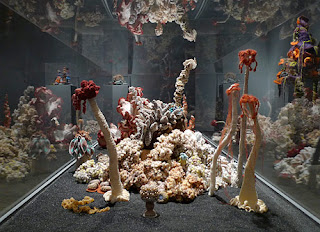Visualizing Nature and its Sea of Changes: Where Art and Science Meet
 |
| The Hyperbolic Coral Reef project has spread around the globe |
Nature is mysterious and some of the magical colors and patterns of the coral reef are a wonder of nature’s artistry. Surprisingly, vegetables such as kale, frissée and other lettuces mimic the free-flowing, wild patterns found in the coral reef. These products of nature form hyperbolic planes, not explained by Euclidean Geometry.
Crochet, a fiber art that traditionally has utilitarian purpose, holds the power to make this mystery visible to our eyes. With this in mind, various hyperbolic coral reef projects have sprung up around the globe, bringing together crochet artists to call attention to the fact that this natural wonder — something akin to the oceans’ natural forest — is vastly disappearing as a result of pollution, human waste and climate change.
 |
| Photo of satellite reef, Föhr, Germany, courtesy Uta Lenk |
The Hyperbolic Coral Reef Project is the brainstorm of Margaret and Christine Wertheim, who founded the Institute for Figuring in Los Angeles to highlight this phenomenon. They based their idea on the discovery of a mathematician at Cornell University, Daina Taimina. Taimina used crochet to unlock a mathematical means to explain the parallel nature of crochet lines in 1997, while the Wertheims further developed a repetoire of reef-life forms: loopy “kelps”, fringed “anemones”, crenelated “sea slugs”, and curlicued “corals.” A simple pattern or algorithm, which has a pure shape can be changed slightly to produce variations and permutations of color and form. The Crochet Reef project began in 2005 and the experiment has involved communities of Reefers, which, like the reef itself, have become worldwide. The Wertheim sisters come from Australia, where the Great Barrier Reef is located, while Taimina is originally from Latvia.
| Photo of Actual Coral Reef, from www.thenowpass.com |
These handmade, collaborative works of fiber art have brought together art, science and math to a worldwide community — for the purpose of the sharing a wonder of nature that could be lost. The replica of a coral reef for the Smithsonian Community Reef was a satellite of the Hyperbolic Crochet Coral Reef Project installed at the Smithsonian National Museum of Natural History in 2010-2011. This project has moved and is on view in the Putnam Museum of History and Natural Science in Davenport, Iowa, where it will remain for 5 years. A former student, Jennifer Lindsay supervised the installation and the public outreach at the Smithsonian and the Putman and is currently coordinating the Artisphere Yarn Bomb in Arlington, Va.
 |
| Postcard from the coral reef project in Föhr, Germany |
This past summer, there was an installation at the Museum Kunst der Westkuste on island of Föhr, in Germany. Over 700 artists from the island, and the mainland of Germany and Denmark came together and contributed to the largest of over 20 worldwide projects around the world. At this moment, there is a satellite of the Hyperbolic Crochet Coral Reef Project at Roanoke College in Salem, Va. It will remain there at the Olin Gallery until March 1, 2013, reminding students at this Liberal Arts College of the fragility of the coral reef.
Artist Elise Richman — who lives on the Puget Sound and teaches at the University of the Puget Sound in Tacoma, Wa — also reminds us that changes are afloat at sea. Richman has different processes of painting, each of which reflect environmental systems and states of flux. In the water-based paintings, she applies inks, acrylics and a liquified powder pigment that has been mixed with powder gum arabic. She pours pools of these paints onto thick sheets of watercolor paper, allowing them to expand, evaporate, be absorbed or intermingle, while using minimum control.
 |
| Elise Richman, Each Form Overflows its Present, mixed media on canvas, 2013, photo by Richard Nicol |
The poured paint dries into forms that evoke the contours of islands, water bodies, and/or fluid dynamics. Richman then takes these contours as boundaries that she can transgress in subsequent layers. “I assert my will by deepening the color, adjusting the quality of particular edges and unifying the compositions while maintaining the dynamic sense of flux that the materials activate,” she explains.
More recently, she has used this technique on large-scale canvases. Her newest water-based paintings, such as Each Form Overflows its Present, I, represent an active state of flux as well as topographical formations. They comment, through implication, on the threat of accelerated changes humans have induced on the environment.
 |
| Elise Richman, Isle I, oil, 12 x 12, 2008 photo by Richard Nicol |
Richman also has a body of three-dimensional oil paintings made of organic dots which seem to grown from the canvases. As one moves around the small, intricately-detailed paintings, the topographies and colors change in visually dynamic ways, maintaining their aesthetic beauty. These forms represent non-hierarchical environments. “They evoke tide-pools of miniature islands; intimate marine scapes act as
 |
| Elise Richman, detail of Pool I, 2010, photo by Richard Nicol |
meditations on the processes of painting, an embodiment of time’s passage, and models of the material world’s interconnectedness,” Richman explained. Each mark, point or dot has its own integrity, yet each is subsumed into a larger whole that has an ethical as well as aesthetic dimension. In short, imbalances of power create exploitations of the natural world and groups of people. Yet this largeness of nature can be maintained in works of art that are personal and meditative. Richman’s website includes works in the encaustic and acrylic paint media. The encaustics have multiple layers, from which she scrapes to represent geological formations.

Recent Comments